Muscle Insider
New member
As a strength athlete, you know what to do to get stronger — you eat, sleep, breathe, and train progressive overload. It’s a grind sometimes, but you ultimately know how to get more weight on that bar. But figuring out how to improve your running speed can feel much more mysterious, especially if running isn’t your primary form...
The post Learn How to Run Faster (At Any Skill Level) From a Triathlete Coach appeared first on BarBend.
As a strength athlete, you know what to do to get stronger — you eat, sleep, breathe, and train progressive overload. It’s a grind sometimes, but you ultimately know how to get more weight on that bar. But figuring out how to improve your running speed can feel much more mysterious, especially if running isn’t your primary form of training.
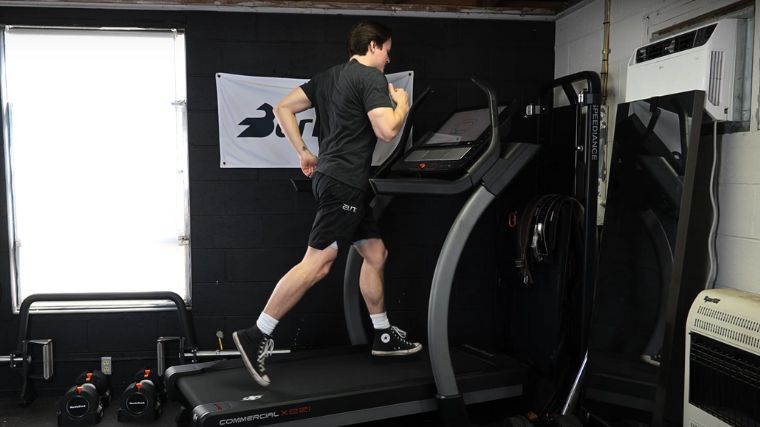
Regardless of your experience level with running, the good news is that you can get faster, even if you don’t identify as a “good runner.” To help you figure out how to run faster, I called up Paul Duncan, who is certified as an Elite Coach by USA Track & Field, and who has coached professional IRONMAN triathletes. He has advice that can help you elevate your level of running competency to the advanced level and beyond.
9 Tips for Running Faster
No matter what running experience you’ve got under your proverbial belt, there are always ways to get faster. Here are your top tips.
For Beginners
If you’re a total beginner, you’re at an exciting stage where almost any strategic step you take to accelerate your running speed is going to pay off. Running is, after all, faster than not running. This is a very exciting part of your journey, and paying heed to the following three tips should rapidly improve your running speed.
1. Form and Technique
While many elite coaches will contend that there is no such thing as a one-size-fits-all proper running form, there is still such a thing as good form. So, it’s ideal to begin with some fundamentals in place.
“When you’re running, try to keep your upper body relaxed and your shoulders down,” Duncan advises. “Shake those arms out, shoulders loose like a goose. A good drill to try to stay loose is to run with a potato chip in each hand. Practice running while holding them in your hands loosely and don’t break them. And don’t forget to land gently on your feet to keep your joints happy.”
To sum that up, we’ve got:
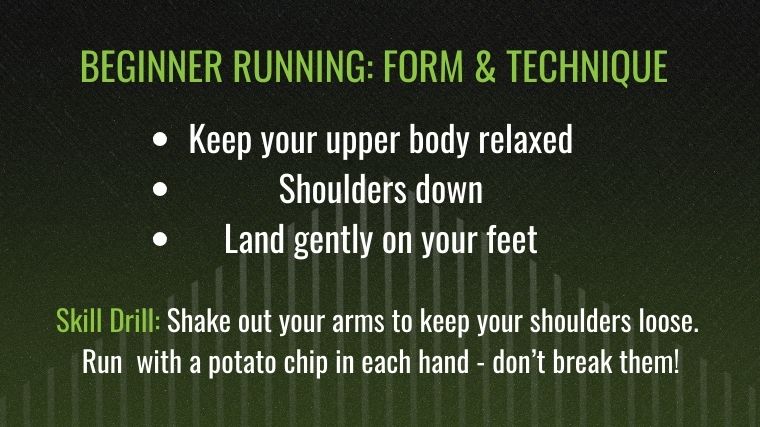
Skill Drill: Shake out your arms to keep your shoulders loose. Run with a potato chip in each hand — don’t break them!
2. Build Endurance
In order to get faster, you’re going to need to run once, and then again — and again. You’ll need to establish a training schedule that gets you out on the track or the treadmill regularly. Not only is this vital to the process of becoming a faster runner, but it’s also essential if you’re ever going to build enough endurance to go on longer runs.
[Read More: The Best Interval Running Workouts and Tips from Top Running Coaches]
“Take it slow and steady at first, like you’re going for a leisurely stroll,” Duncan suggests. “Try running a few times a week and gradually increase your distance over time. Remember, it’s all about pacing yourself. If you ever feel tired or achy, it’s OK to take a break and rest, while keeping in mind the need for consistency. Frequency trumps any single workout. For newer runners that I coach, I will almost always include no speed work in the mix until they have built up a foundation of easy miles first. Get into the habit.”
All told:
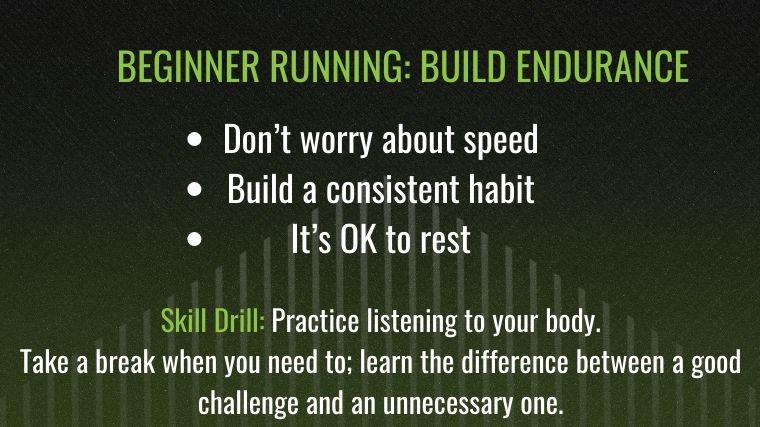
Skill Drill: Practice listening to your body. Take a break when you need to, and learn the difference between a good challenge and an unnecessary one (when you should probably rest instead).
3. Strength and Flexibility
It may seem like the key to running faster is simply to do as much running as possible and hope for the best. However, part and parcel to running faster — and also maturing into your optimal running form — is working on other aspects of physical development. This includes enhancing your strength and flexibility.
[Read More: How to Balance Running and Strength Training, No Matter Your Goals]
“Running isn’t just about running! You also need to build strength and flexibility,” says Duncan. “Many runners, including myself, fail on this front. We could always be better here. Incorporate some squats, lunges, and stretches into your routine to keep your muscles happy. And don’t forget to warm up before you run to get your body ready for action.”
In summary:
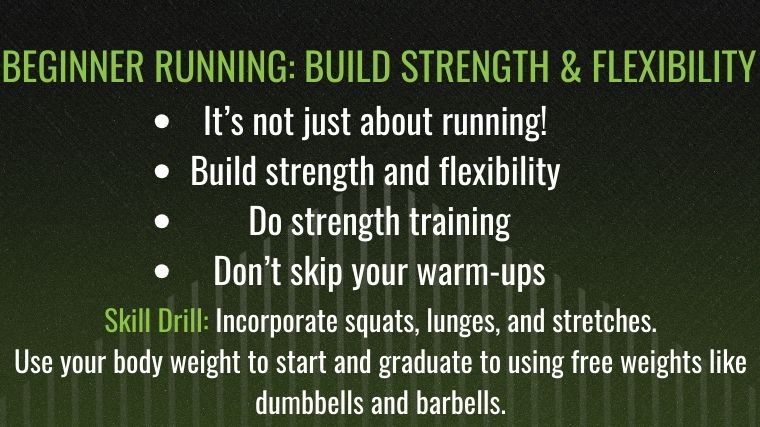
Skill Drill: Incorporate squats, lunges, and stretches into your routine. Use your body weight to start and graduate to using free weights like dumbbells and barbells.
For Intermediate Runners
Once you’ve been running for a while, your training gets far more precise — but it also gets slightly more precarious. You can still do a lot to get faster, but you’ll now need a strategic approach to engage all of your energy systems and improve your running economy.
At the same time, increasing your training intensity means your risk of injury is also potentially heightened. The next three tips take all of that into account.
1. Structured Speed Workouts
Now that you’ve developed enough endurance to run potentially every day of the week, you can start mixing up the types of runs you’re doing. This means you can do some interval and Fartlek training to get accustomed to moving at faster speeds. You can also throw in some tempo runs to force yourself to sustain a specific race pace.
[Read More: How To Build Stamina for Running: 6 Tips + Benefits]
“You’ve built a foundation of mileage over weeks and months, so your body should be more durable and ready to handle more intensity,” explains Duncan. “Now let’s kick things up a notch. Try mixing up your runs with different speeds, like sprinting for a bit, then slowing down, then sprinting again. You’ll feel a sense of accomplishment with each completed workout!”
The recap:
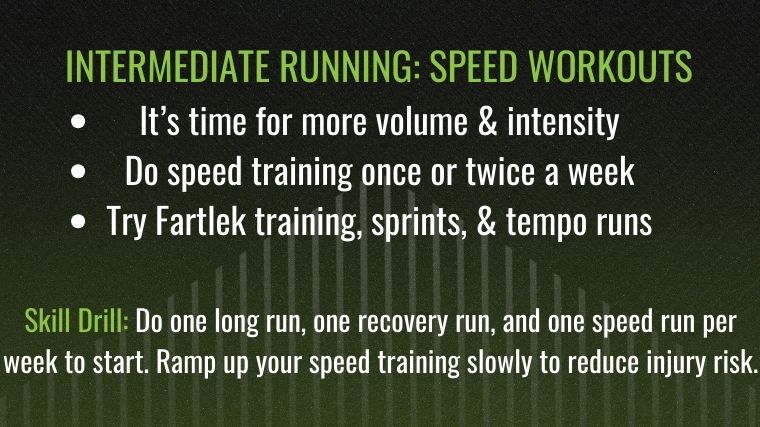
Skill Drill: Do one long run, one recovery run, and one speed run per week to start. Ramp up your speed training slowly to reduce injury risk.
2. Healthy Habits and Rest
You may be giving it your all during your training, but you can build up your fitness level and running performance most effectively with healthy resting and eating habits. Without fueling your body enough for your runs — and sleeping enough to recharge — you’re less able to get faster, no matter how hard you work on your favorite treadmill for running.
[Read More: Does Running Burn Fat? The Science Behind This Cardio Myth]
“Remember to fuel your body with good stuff like fruits, veggies, and protein,” says Duncan. “You do not need to go overboard with carbohydrates. Just keep it balanced and healthy. Also, make sure to give yourself plenty of rest between workouts. Your body needs time to recover and get stronger!”
Your goals:
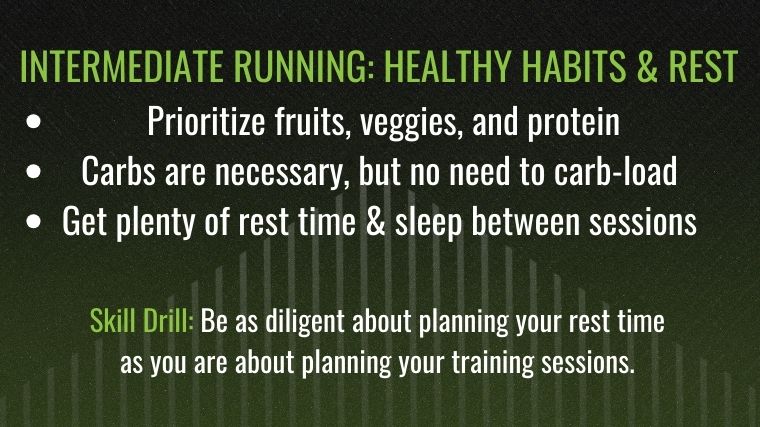
Skill Drill: Be as diligent about planning your rest time as you are about planning your training sessions.
3. Fun Drills and Exercise
Aside from the standard running workouts, there are other movements you can do to warm up and strengthen your quads, hamstrings, glutes, and core muscles during training. On top of adding some variety to your training sessions, they also serve the practical purpose of making your workouts more thorough.
[Read More: Running on a Treadmill Vs. Running Outside — Which Is Best for Your Goals?]
“Add some excitement to your workouts by trying out fun drills and exercises,” says Duncan. “Jumping exercises and other dynamic movements can help make your legs stronger and your body faster. It’s like having a blast while getting fit!”
Rounding it out:
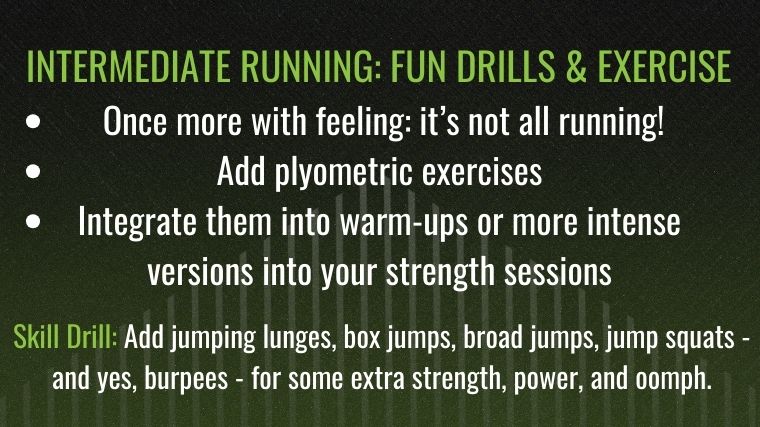
Skill Drill: Add jumping lunges, box jumps, broad jumps, jump squats — and yes, burpees — for some extra strength, power, and oomph.
For Advanced Runners
Once you’re an advanced runner, you’ll capitalize on every trick possible to shave even tenths of seconds off of your running times. This means that everything you do between your warm-up and cool-down is carefully planned, even down to the running shoes and running gear you use.
1. Challenging Workouts
Once you’re an advanced runner, that’s when you truly start focusing on squeezing every last millisecond of speed out of your body so that it’s ready for race day. This will certainly be hard, but it also means adding a dimension of fun and variety to your speed training as you strive to optimize your race time.
“You need to have progressive overload — your intensity and volume should be increasing over time,” states Duncan. “Try incorporating tougher workouts into your routine, like hill training or maintaining a faster running pace for longer distances. It might be tough, but the sense of accomplishment afterward will be worth it! Track workouts can also be an important element of your training, depending on your running goals. A staple track workout for marathon runners might be something like one-mile repeats on the track at a faster pace than racing pace.”
To summarize:
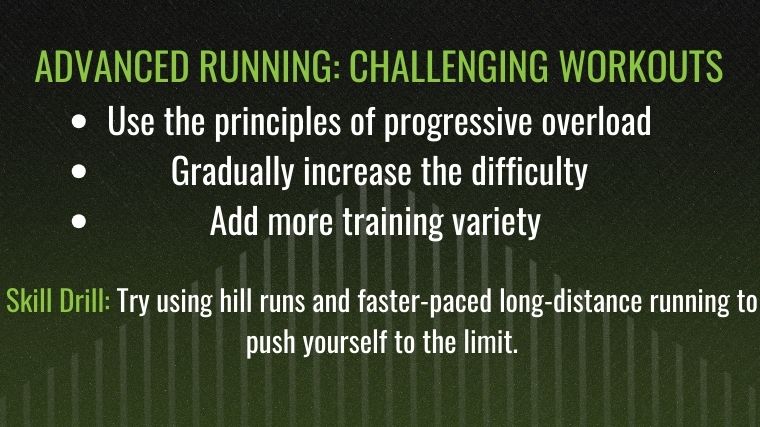
Skill Drill: Try using hill runs and faster-paced long-distance running to push yourself to the limit.
2. Importance of Recovery
Because you’re pushing yourself to the point of exhaustion during your workouts, you also need to get the most out of every opportunity to replenish your energy. This can mean taking regular rest days or running at a slower pace on days when you can tell you’d be doing more harm than good by going all out.
[Read More: The Best 8 Stretches to Do Before a Run, According to a CPT]
“Even the best runners need to take breaks,” insists Duncan. “Make sure you’re giving yourself enough time to rest and recover after intense workouts. And keep fueling your body with nutritious foods to stay strong and energized. A break means something different to the individual. Personally, I run seven days a week, but I make sure many of those runs are very easy to make sure I recover. A good coach can also help you build a sustainable plan, where you increase little by little over the course of each workout while making sure you are getting enough recovery at the same time.”
Here’s what that means in action:
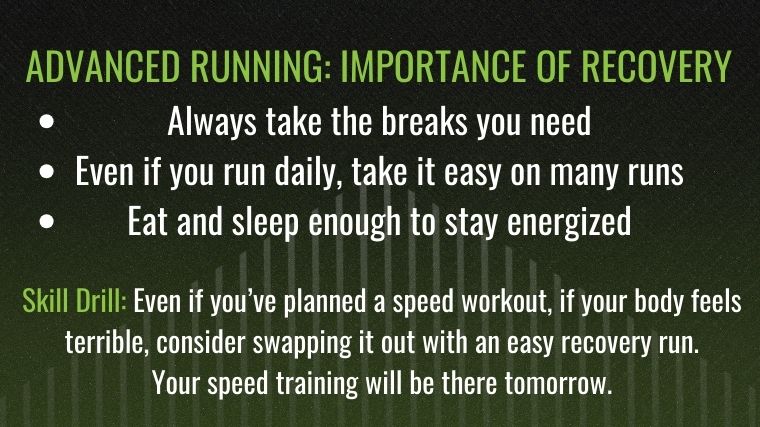
Skill Drill: Even if you’ve planned a speed workout, if your body feels terrible, consider swapping it out with an easy recovery run. Your speed training will be there tomorrow.
3. Refining Technique
Although your structured running and strength work will have greatly improved your running form by this stage, there are still ways you can go about making your running form even better. This is especially helpful if you are a sprinter or a long-distance specialist, and you’re trying to maximize your efficiency during a sprint or distance run.
[Read More: Best Cardio Alternatives to Running, From a Personal Trainer]
“Hone your running skills by practicing different techniques, such as skipping or running with high knees,” suggests Duncan. “These variations can help improve your running form and efficiency, making you an even better runner!”
Last, but not least:
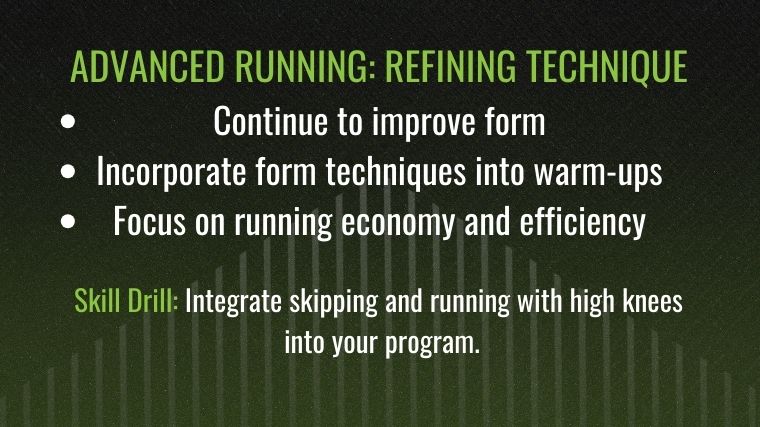
Skill Drill: Integrate skipping and running with high knees into your program.
FAQs
Still have questions? No problem. We’ve still got answers.
How can I boost my running speed?
There are several strategies you can use to boost your running speed depending upon your experience level. However, a good training structure at any level includes challenging running workouts containing distance running and speed work. It is also recommended that you do strength training for your legs and core muscles, and adopt balanced eating and recovery habits.
Why do I run so slow?
Slow is a relative term, but some reasons why your running speed might not match your speed potential might include a lack of endurance or improper form.
What are the best ways to improve my speed?
Improving your top speed can be accomplished through high-intensity runs that elevate your heart rate beyond your aerobic training zone. But, you’ll also want to go on longer, slower runs to improve your cardio capacity. If you combine this in a cross-training program with lower-body strength training, this is a recipe that will help you pick up speed at a rapid rate.
The post Learn How to Run Faster (At Any Skill Level) From a Triathlete Coach appeared first on BarBend.
Click here to view the article.
The post Learn How to Run Faster (At Any Skill Level) From a Triathlete Coach appeared first on BarBend.
As a strength athlete, you know what to do to get stronger — you eat, sleep, breathe, and train progressive overload. It’s a grind sometimes, but you ultimately know how to get more weight on that bar. But figuring out how to improve your running speed can feel much more mysterious, especially if running isn’t your primary form of training.

Regardless of your experience level with running, the good news is that you can get faster, even if you don’t identify as a “good runner.” To help you figure out how to run faster, I called up Paul Duncan, who is certified as an Elite Coach by USA Track & Field, and who has coached professional IRONMAN triathletes. He has advice that can help you elevate your level of running competency to the advanced level and beyond.
9 Tips for Running Faster
No matter what running experience you’ve got under your proverbial belt, there are always ways to get faster. Here are your top tips.
For Beginners
If you’re a total beginner, you’re at an exciting stage where almost any strategic step you take to accelerate your running speed is going to pay off. Running is, after all, faster than not running. This is a very exciting part of your journey, and paying heed to the following three tips should rapidly improve your running speed.
1. Form and Technique
While many elite coaches will contend that there is no such thing as a one-size-fits-all proper running form, there is still such a thing as good form. So, it’s ideal to begin with some fundamentals in place.
“When you’re running, try to keep your upper body relaxed and your shoulders down,” Duncan advises. “Shake those arms out, shoulders loose like a goose. A good drill to try to stay loose is to run with a potato chip in each hand. Practice running while holding them in your hands loosely and don’t break them. And don’t forget to land gently on your feet to keep your joints happy.”
To sum that up, we’ve got:

- Upper body relaxed
- Shoulders down
- Land gently on your feet
Skill Drill: Shake out your arms to keep your shoulders loose. Run with a potato chip in each hand — don’t break them!
2. Build Endurance
In order to get faster, you’re going to need to run once, and then again — and again. You’ll need to establish a training schedule that gets you out on the track or the treadmill regularly. Not only is this vital to the process of becoming a faster runner, but it’s also essential if you’re ever going to build enough endurance to go on longer runs.
[Read More: The Best Interval Running Workouts and Tips from Top Running Coaches]
“Take it slow and steady at first, like you’re going for a leisurely stroll,” Duncan suggests. “Try running a few times a week and gradually increase your distance over time. Remember, it’s all about pacing yourself. If you ever feel tired or achy, it’s OK to take a break and rest, while keeping in mind the need for consistency. Frequency trumps any single workout. For newer runners that I coach, I will almost always include no speed work in the mix until they have built up a foundation of easy miles first. Get into the habit.”
All told:

- Don’t worry about speed when you’re first starting out
- Build a consistent habit with slow, steady walks and runs
- It’s OK to rest
Skill Drill: Practice listening to your body. Take a break when you need to, and learn the difference between a good challenge and an unnecessary one (when you should probably rest instead).
3. Strength and Flexibility
It may seem like the key to running faster is simply to do as much running as possible and hope for the best. However, part and parcel to running faster — and also maturing into your optimal running form — is working on other aspects of physical development. This includes enhancing your strength and flexibility.
[Read More: How to Balance Running and Strength Training, No Matter Your Goals]
“Running isn’t just about running! You also need to build strength and flexibility,” says Duncan. “Many runners, including myself, fail on this front. We could always be better here. Incorporate some squats, lunges, and stretches into your routine to keep your muscles happy. And don’t forget to warm up before you run to get your body ready for action.”
In summary:

- It’s not just about running!
- Build strength and flexibility
- Do strength training
- Don’t skip your warm-ups
Skill Drill: Incorporate squats, lunges, and stretches into your routine. Use your body weight to start and graduate to using free weights like dumbbells and barbells.
For Intermediate Runners
Once you’ve been running for a while, your training gets far more precise — but it also gets slightly more precarious. You can still do a lot to get faster, but you’ll now need a strategic approach to engage all of your energy systems and improve your running economy.
At the same time, increasing your training intensity means your risk of injury is also potentially heightened. The next three tips take all of that into account.
1. Structured Speed Workouts
Now that you’ve developed enough endurance to run potentially every day of the week, you can start mixing up the types of runs you’re doing. This means you can do some interval and Fartlek training to get accustomed to moving at faster speeds. You can also throw in some tempo runs to force yourself to sustain a specific race pace.
[Read More: How To Build Stamina for Running: 6 Tips + Benefits]
“You’ve built a foundation of mileage over weeks and months, so your body should be more durable and ready to handle more intensity,” explains Duncan. “Now let’s kick things up a notch. Try mixing up your runs with different speeds, like sprinting for a bit, then slowing down, then sprinting again. You’ll feel a sense of accomplishment with each completed workout!”
The recap:

- Your body should be ready for more volume (and intensity)
- Use different speed training techniques once or twice a week
- Some options are Fartlek training, sprint workouts, and tempo runs
Skill Drill: Do one long run, one recovery run, and one speed run per week to start. Ramp up your speed training slowly to reduce injury risk.
2. Healthy Habits and Rest
You may be giving it your all during your training, but you can build up your fitness level and running performance most effectively with healthy resting and eating habits. Without fueling your body enough for your runs — and sleeping enough to recharge — you’re less able to get faster, no matter how hard you work on your favorite treadmill for running.
[Read More: Does Running Burn Fat? The Science Behind This Cardio Myth]
“Remember to fuel your body with good stuff like fruits, veggies, and protein,” says Duncan. “You do not need to go overboard with carbohydrates. Just keep it balanced and healthy. Also, make sure to give yourself plenty of rest between workouts. Your body needs time to recover and get stronger!”
Your goals:

- Prioritize fruits, veggies, and protein
- Carbs are necessary for fueling your workouts, but no need to carb-load
- Get plenty of rest time and sleep between sessions
Skill Drill: Be as diligent about planning your rest time as you are about planning your training sessions.
3. Fun Drills and Exercise
Aside from the standard running workouts, there are other movements you can do to warm up and strengthen your quads, hamstrings, glutes, and core muscles during training. On top of adding some variety to your training sessions, they also serve the practical purpose of making your workouts more thorough.
[Read More: Running on a Treadmill Vs. Running Outside — Which Is Best for Your Goals?]
“Add some excitement to your workouts by trying out fun drills and exercises,” says Duncan. “Jumping exercises and other dynamic movements can help make your legs stronger and your body faster. It’s like having a blast while getting fit!”
Rounding it out:

- Once more with feeling: it’s not all about running!
- Add plyometric exercises to your training regimen
- Integrate them into warm-ups or more intense versions into your strength sessions
Skill Drill: Add jumping lunges, box jumps, broad jumps, jump squats — and yes, burpees — for some extra strength, power, and oomph.
For Advanced Runners
Once you’re an advanced runner, you’ll capitalize on every trick possible to shave even tenths of seconds off of your running times. This means that everything you do between your warm-up and cool-down is carefully planned, even down to the running shoes and running gear you use.
1. Challenging Workouts
Once you’re an advanced runner, that’s when you truly start focusing on squeezing every last millisecond of speed out of your body so that it’s ready for race day. This will certainly be hard, but it also means adding a dimension of fun and variety to your speed training as you strive to optimize your race time.
“You need to have progressive overload — your intensity and volume should be increasing over time,” states Duncan. “Try incorporating tougher workouts into your routine, like hill training or maintaining a faster running pace for longer distances. It might be tough, but the sense of accomplishment afterward will be worth it! Track workouts can also be an important element of your training, depending on your running goals. A staple track workout for marathon runners might be something like one-mile repeats on the track at a faster pace than racing pace.”
To summarize:

- Use the principles of progressive overload
- Gradually increase the difficulty of your workouts
- Add more training variety to your repertoire
Skill Drill: Try using hill runs and faster-paced long-distance running to push yourself to the limit.
2. Importance of Recovery
Because you’re pushing yourself to the point of exhaustion during your workouts, you also need to get the most out of every opportunity to replenish your energy. This can mean taking regular rest days or running at a slower pace on days when you can tell you’d be doing more harm than good by going all out.
[Read More: The Best 8 Stretches to Do Before a Run, According to a CPT]
“Even the best runners need to take breaks,” insists Duncan. “Make sure you’re giving yourself enough time to rest and recover after intense workouts. And keep fueling your body with nutritious foods to stay strong and energized. A break means something different to the individual. Personally, I run seven days a week, but I make sure many of those runs are very easy to make sure I recover. A good coach can also help you build a sustainable plan, where you increase little by little over the course of each workout while making sure you are getting enough recovery at the same time.”
Here’s what that means in action:

- Always take the breaks you need
- Even if you run every day, many of those runs should be easy and low-intensity
- Eat and sleep enough to stay energized
Skill Drill: Even if you’ve planned a speed workout, if your body feels terrible, consider swapping it out with an easy recovery run. Your speed training will be there tomorrow.
3. Refining Technique
Although your structured running and strength work will have greatly improved your running form by this stage, there are still ways you can go about making your running form even better. This is especially helpful if you are a sprinter or a long-distance specialist, and you’re trying to maximize your efficiency during a sprint or distance run.
[Read More: Best Cardio Alternatives to Running, From a Personal Trainer]
“Hone your running skills by practicing different techniques, such as skipping or running with high knees,” suggests Duncan. “These variations can help improve your running form and efficiency, making you an even better runner!”
Last, but not least:

- Continue to improve form
- Incorporate form techniques into dynamic warm-ups
- Focus on running economy and efficiency
Skill Drill: Integrate skipping and running with high knees into your program.
FAQs
Still have questions? No problem. We’ve still got answers.
How can I boost my running speed?
There are several strategies you can use to boost your running speed depending upon your experience level. However, a good training structure at any level includes challenging running workouts containing distance running and speed work. It is also recommended that you do strength training for your legs and core muscles, and adopt balanced eating and recovery habits.
Why do I run so slow?
Slow is a relative term, but some reasons why your running speed might not match your speed potential might include a lack of endurance or improper form.
What are the best ways to improve my speed?
Improving your top speed can be accomplished through high-intensity runs that elevate your heart rate beyond your aerobic training zone. But, you’ll also want to go on longer, slower runs to improve your cardio capacity. If you combine this in a cross-training program with lower-body strength training, this is a recipe that will help you pick up speed at a rapid rate.
The post Learn How to Run Faster (At Any Skill Level) From a Triathlete Coach appeared first on BarBend.
Click here to view the article.

